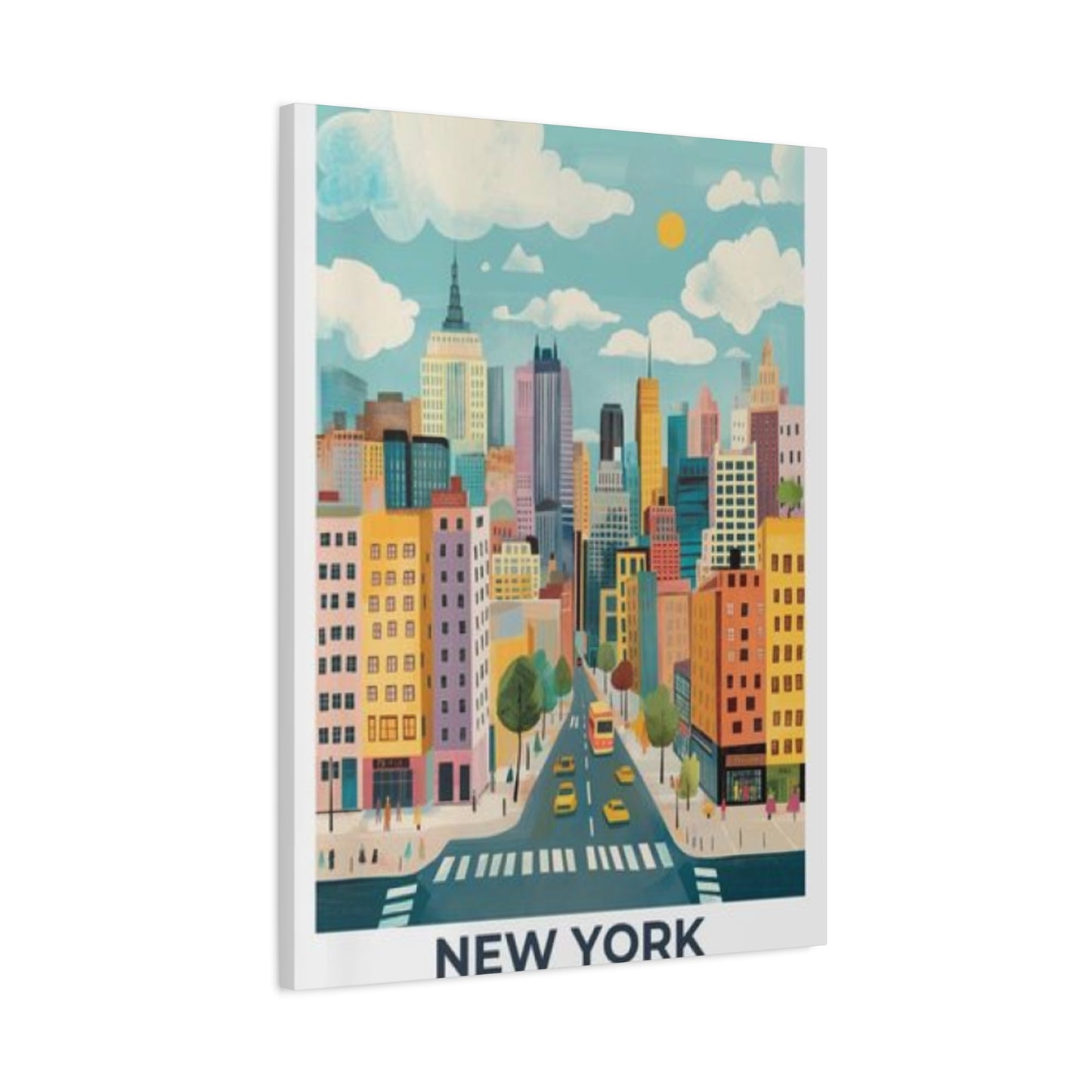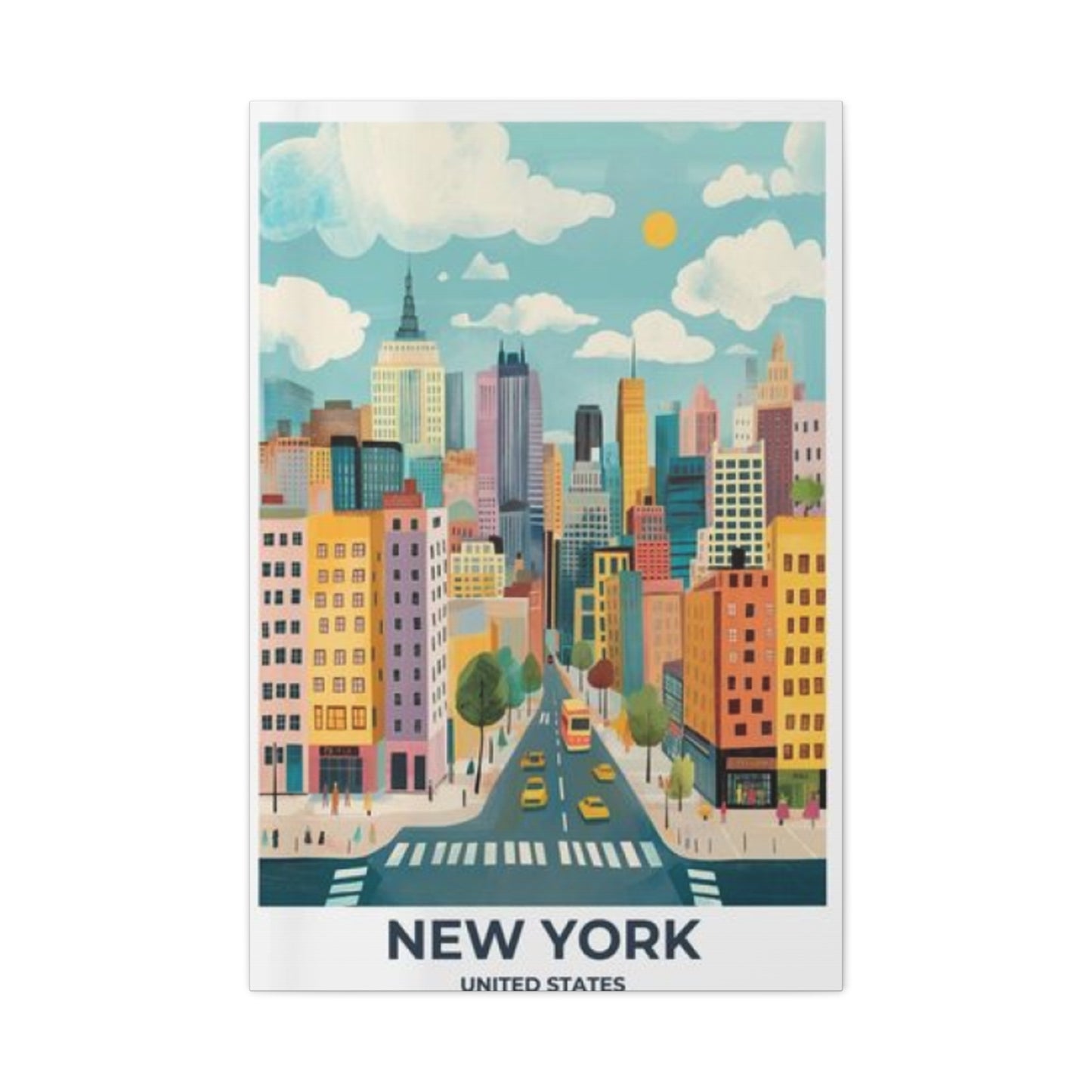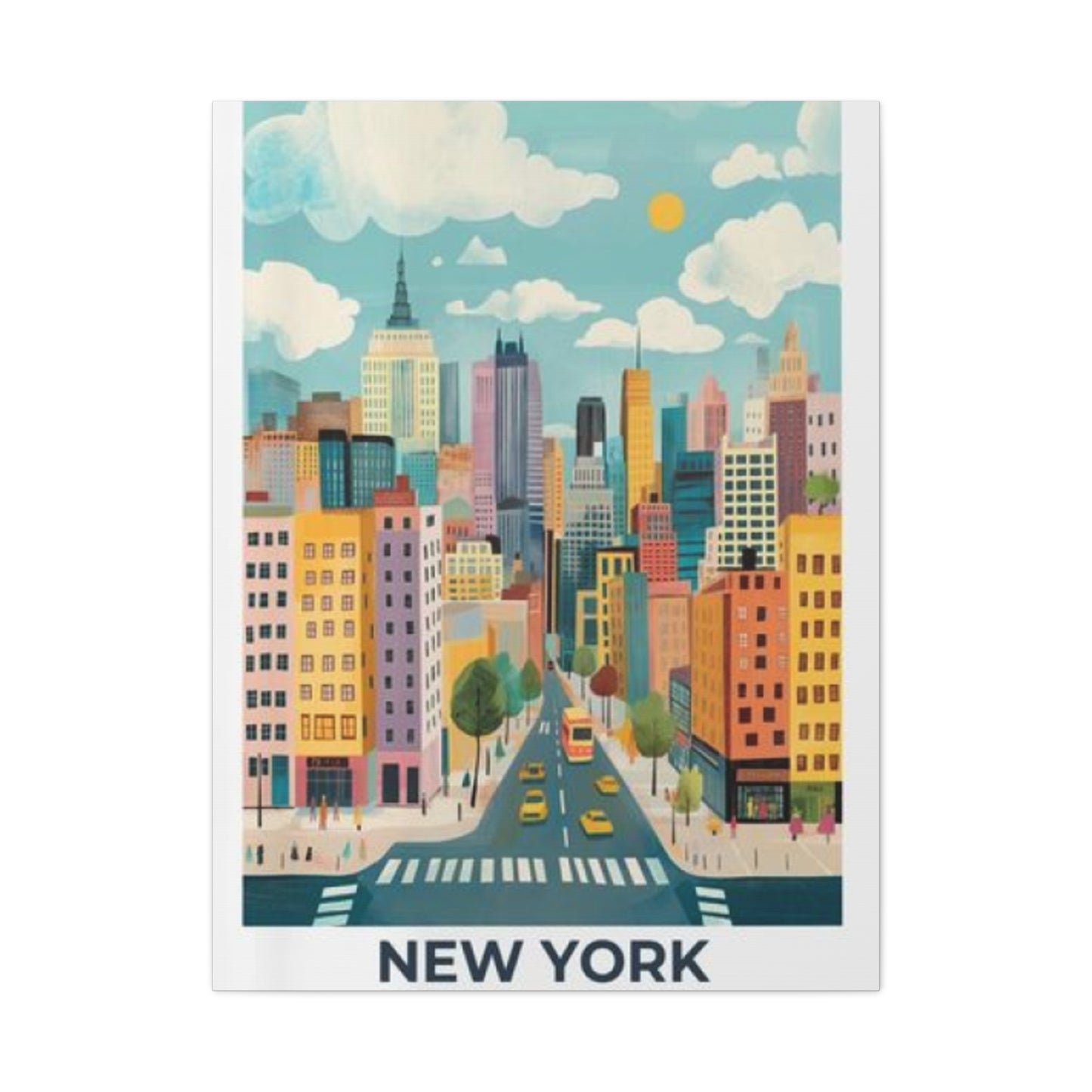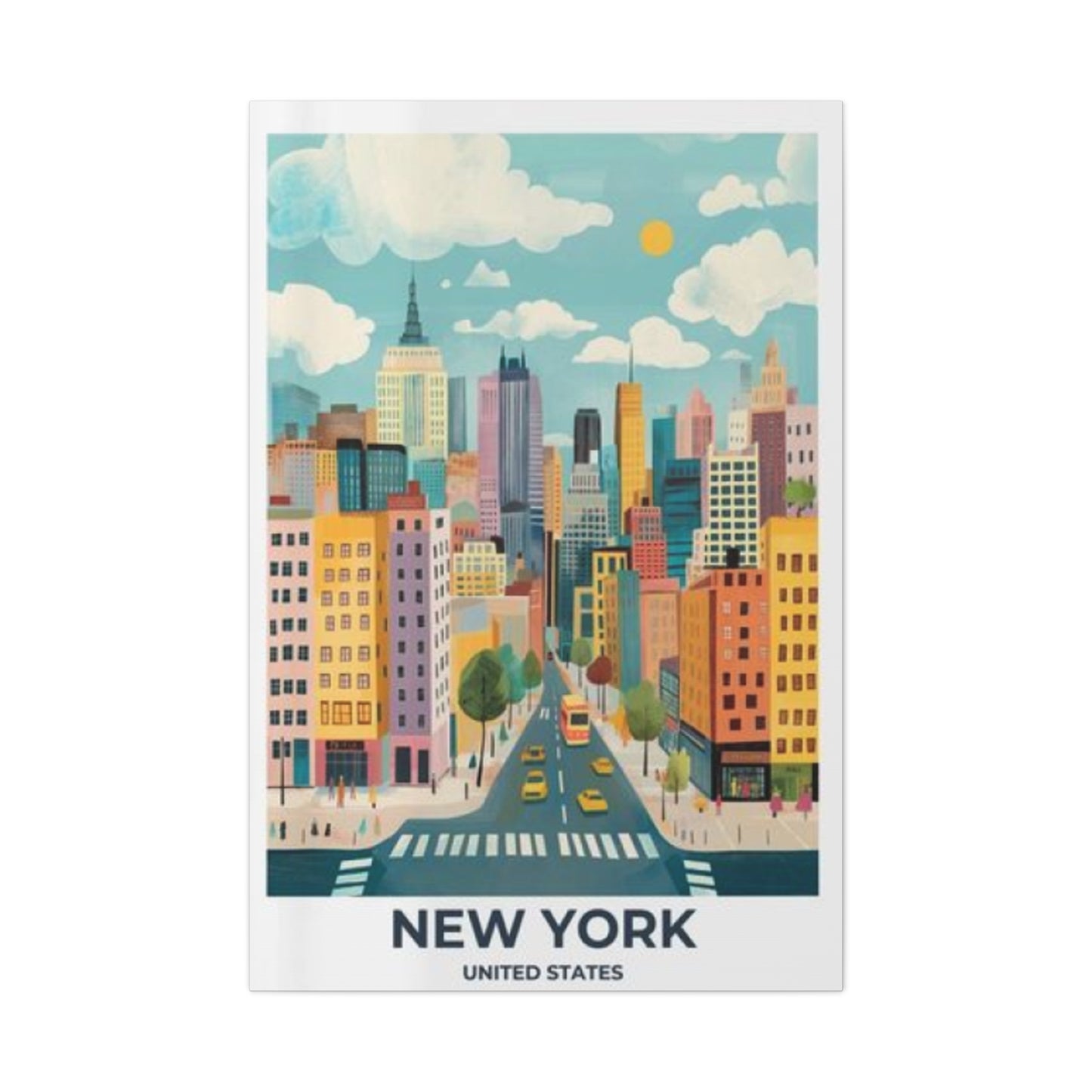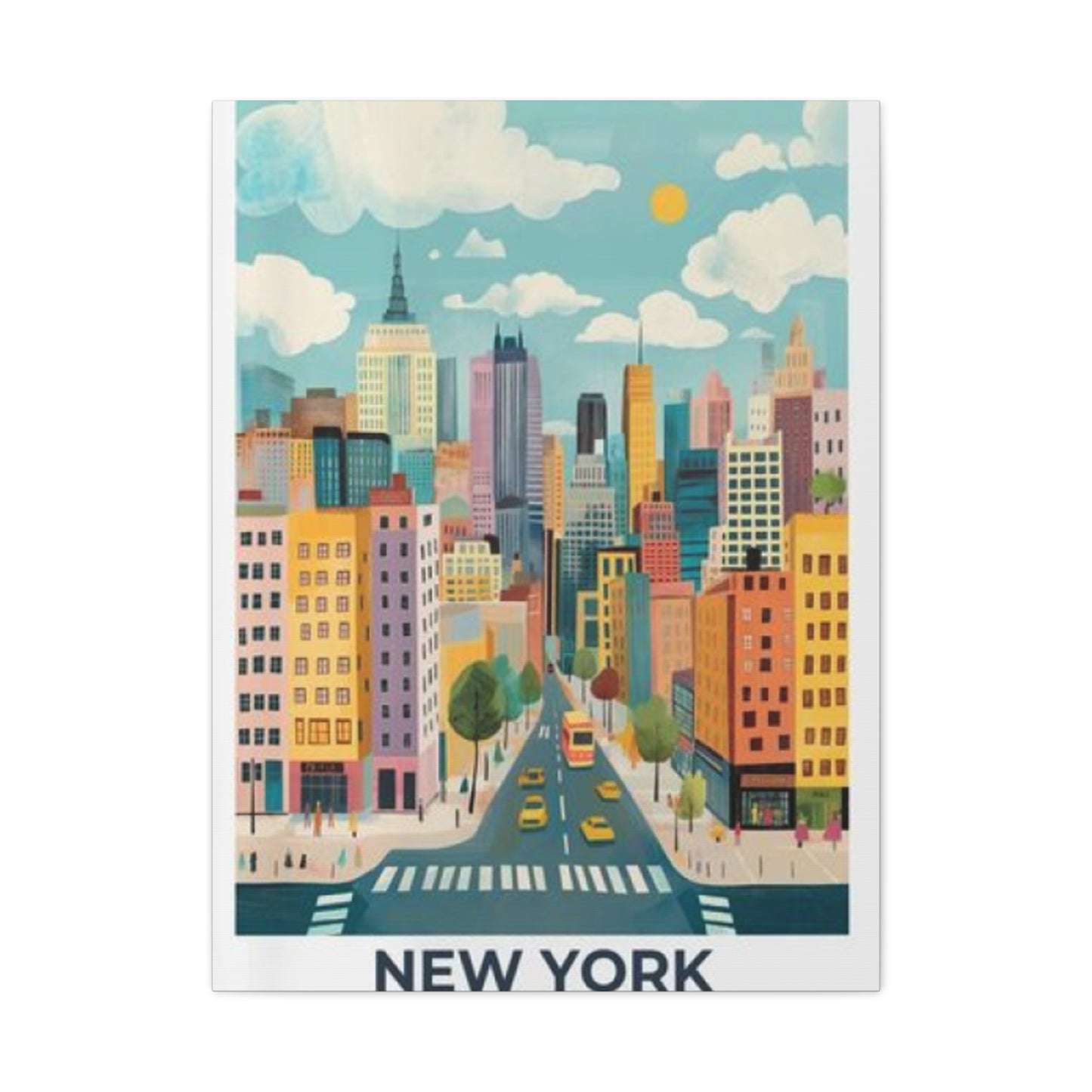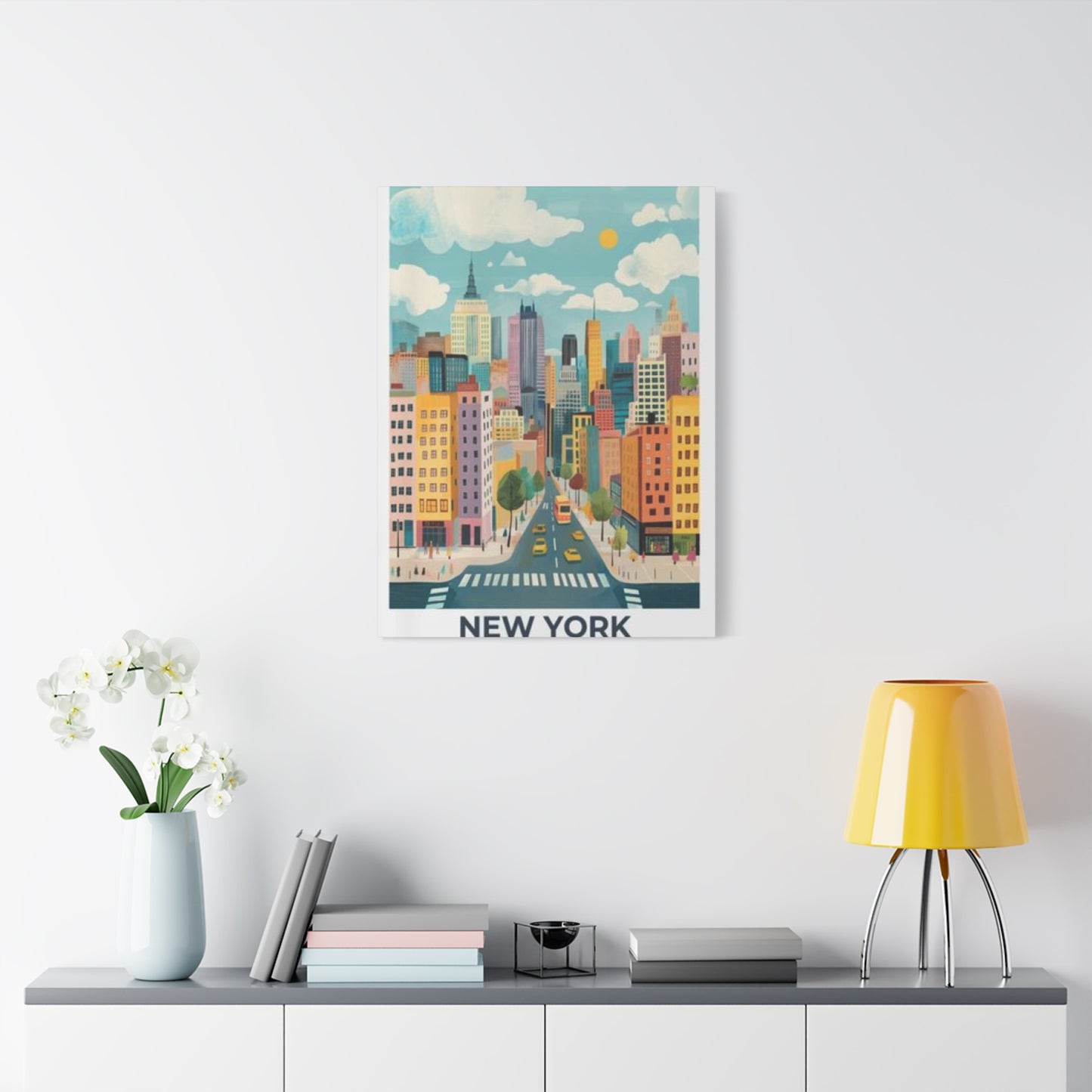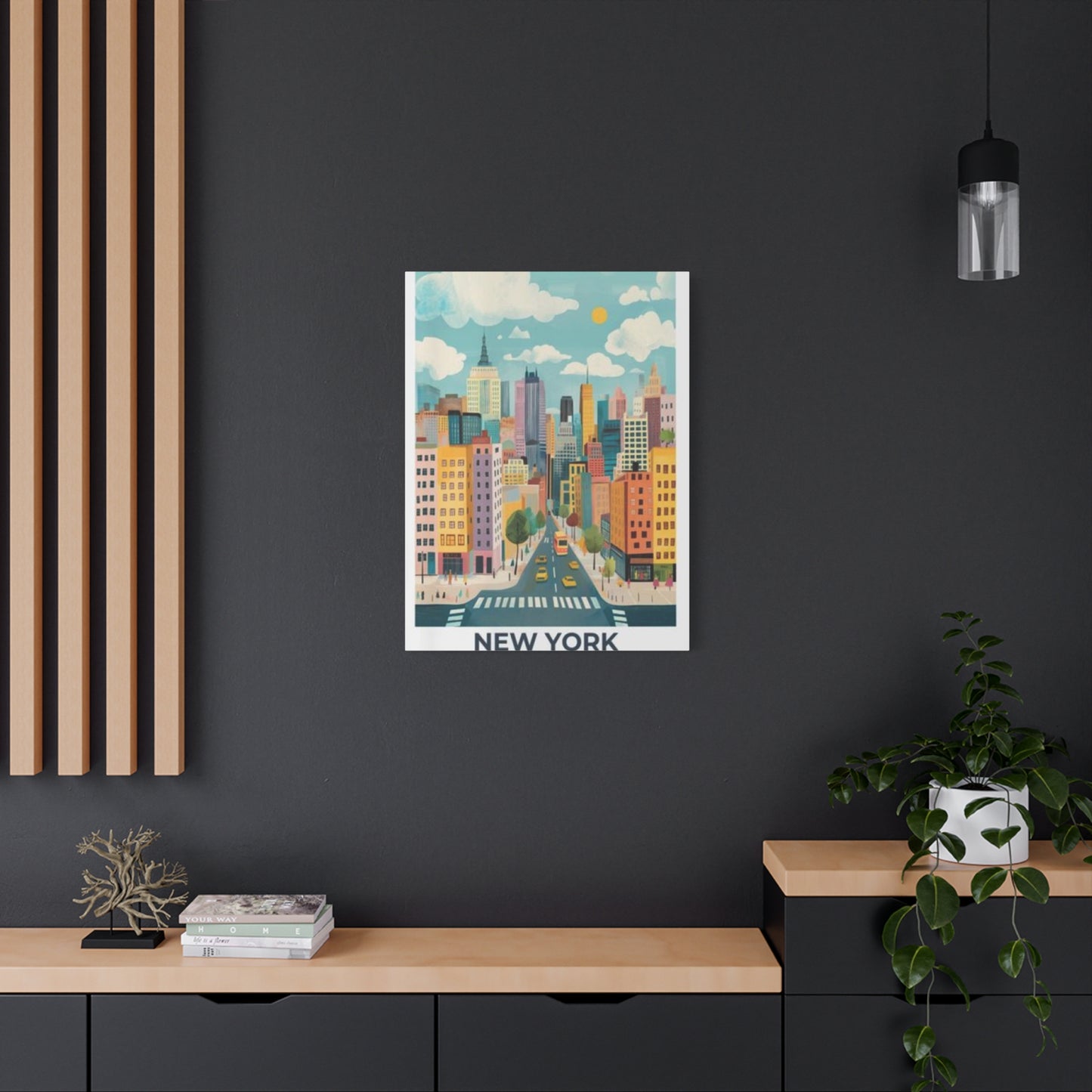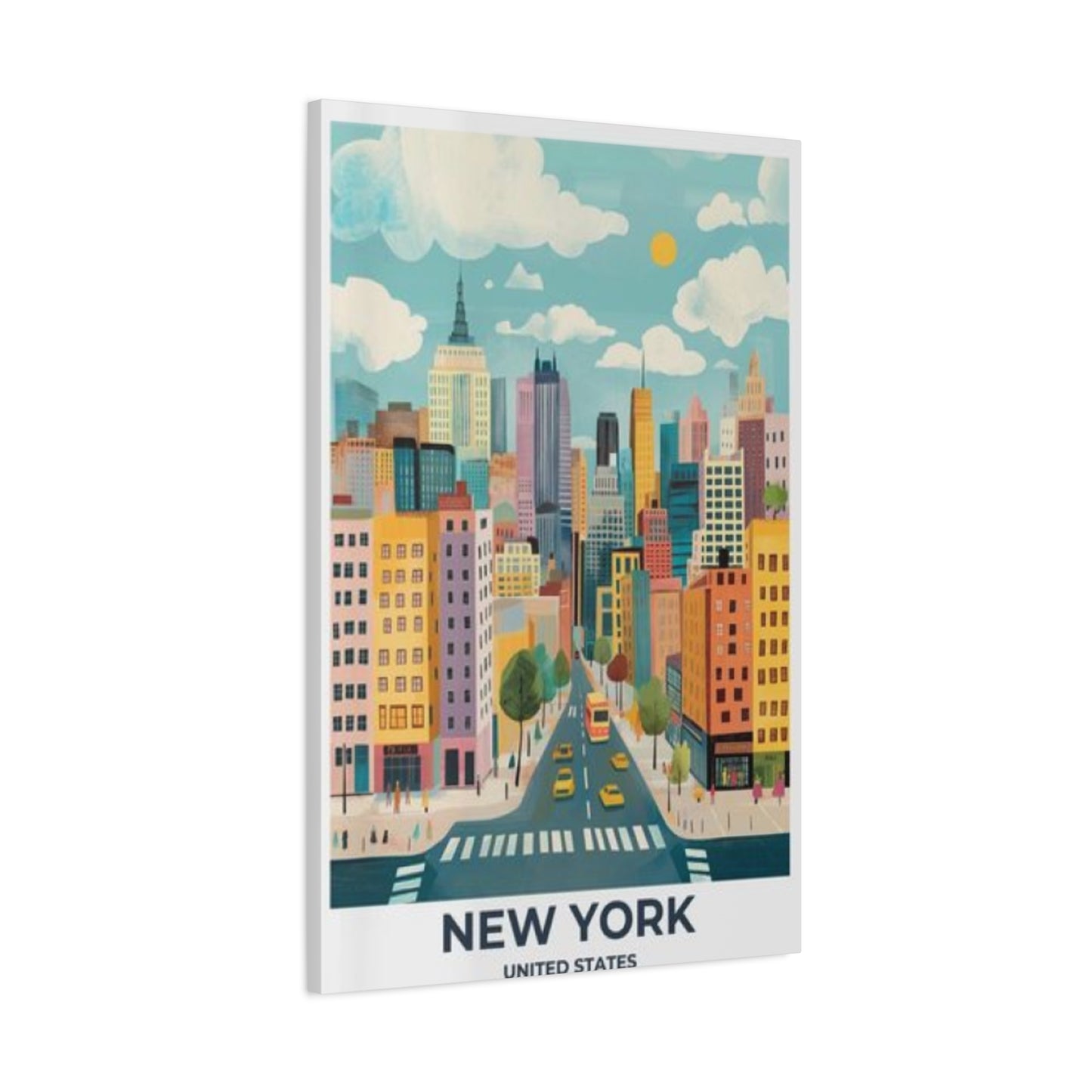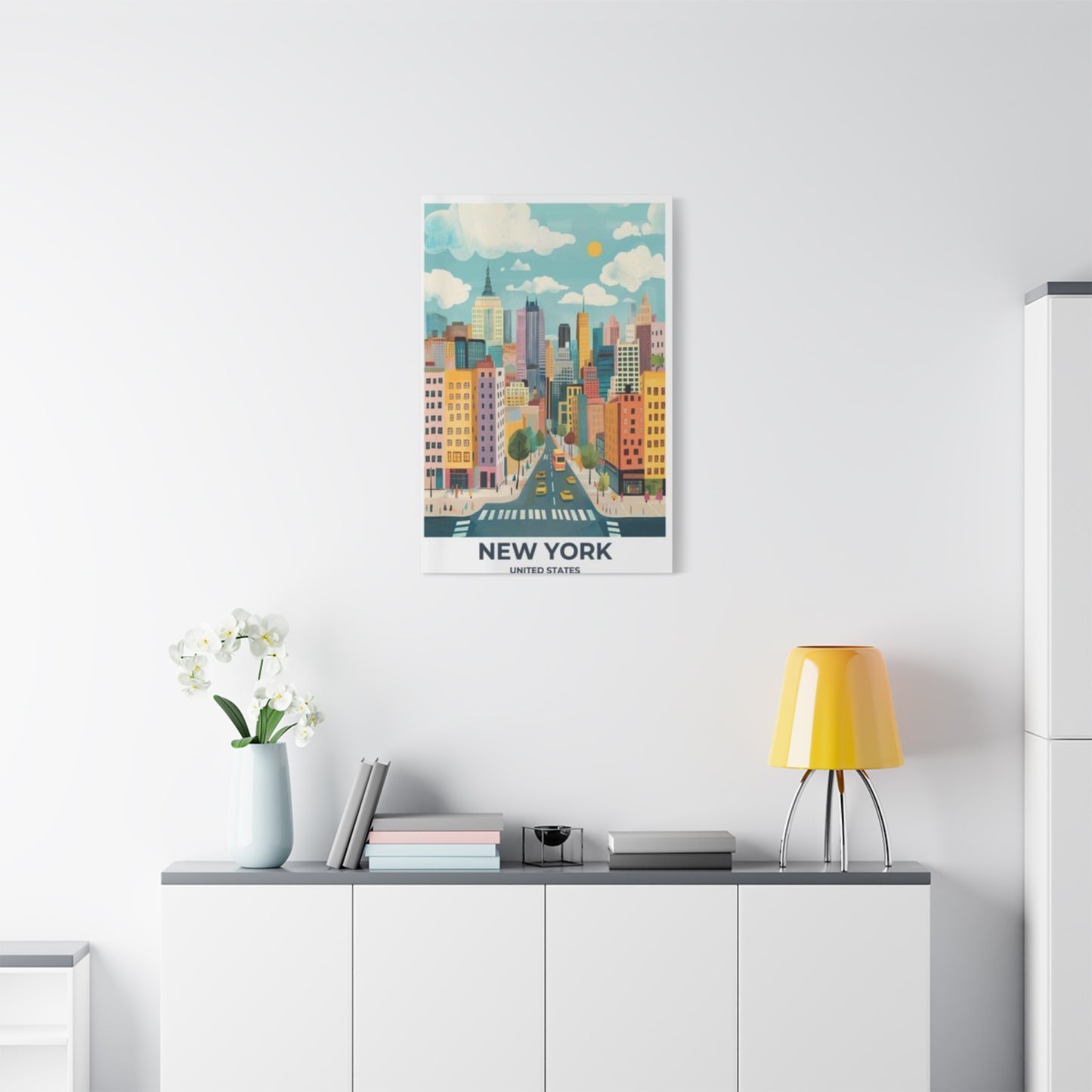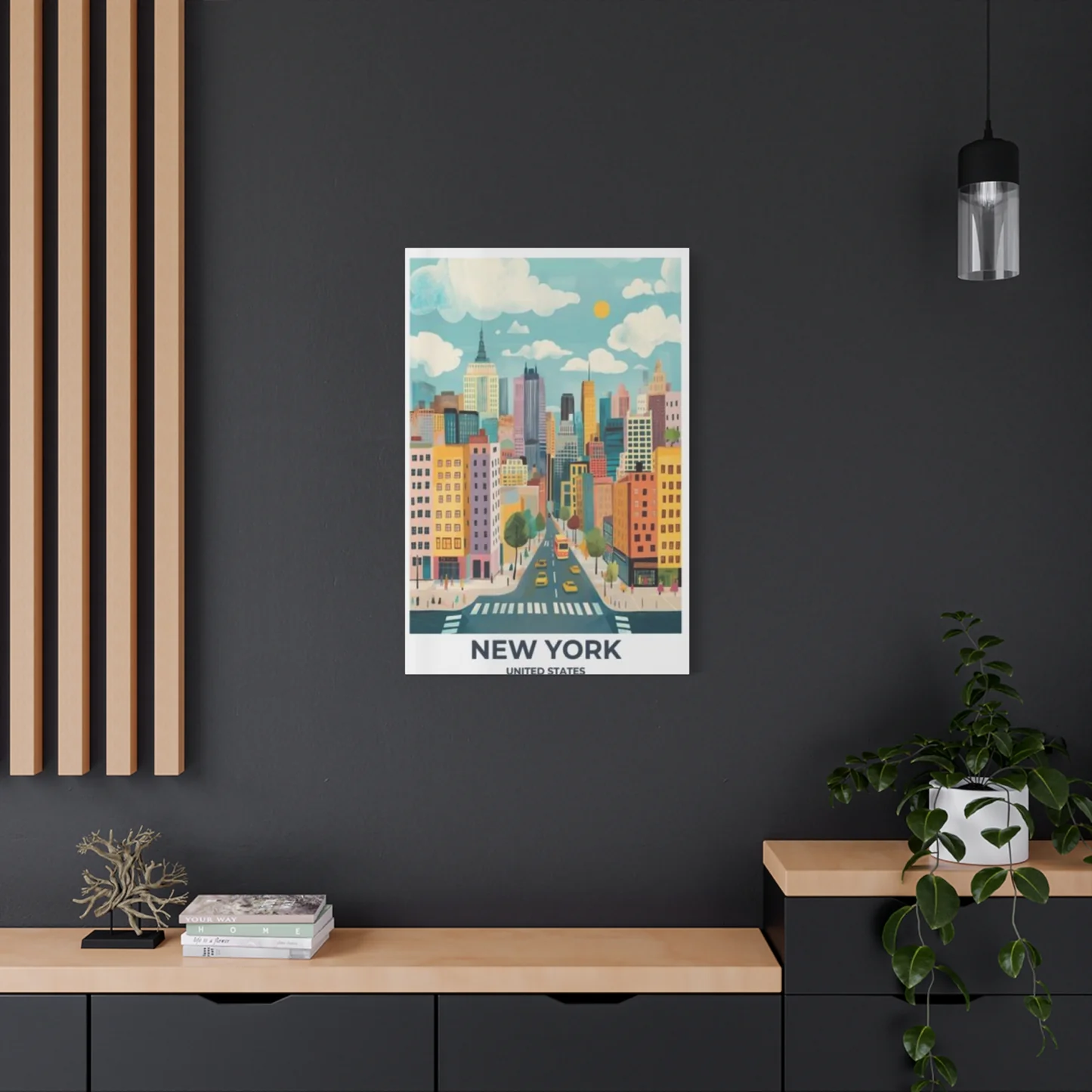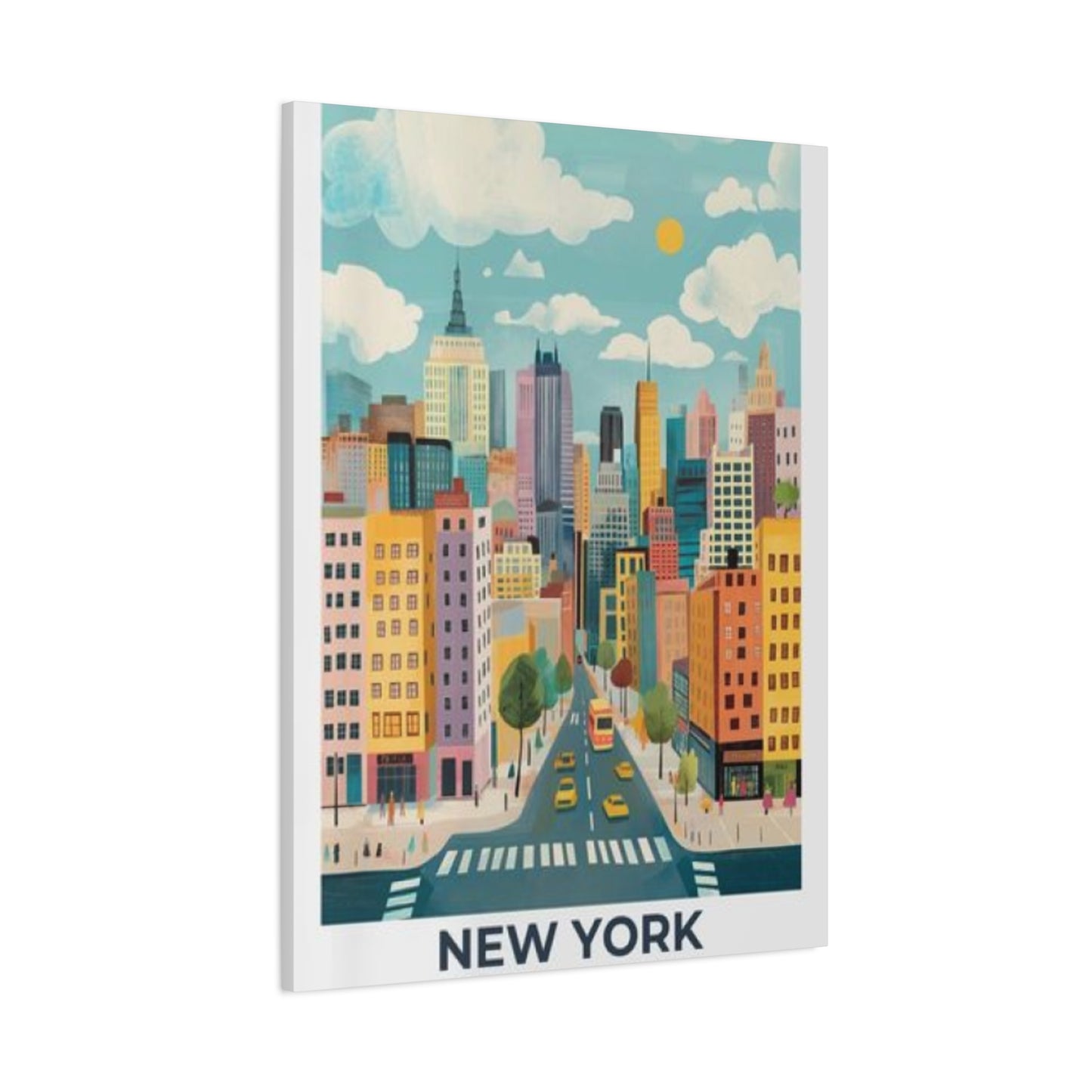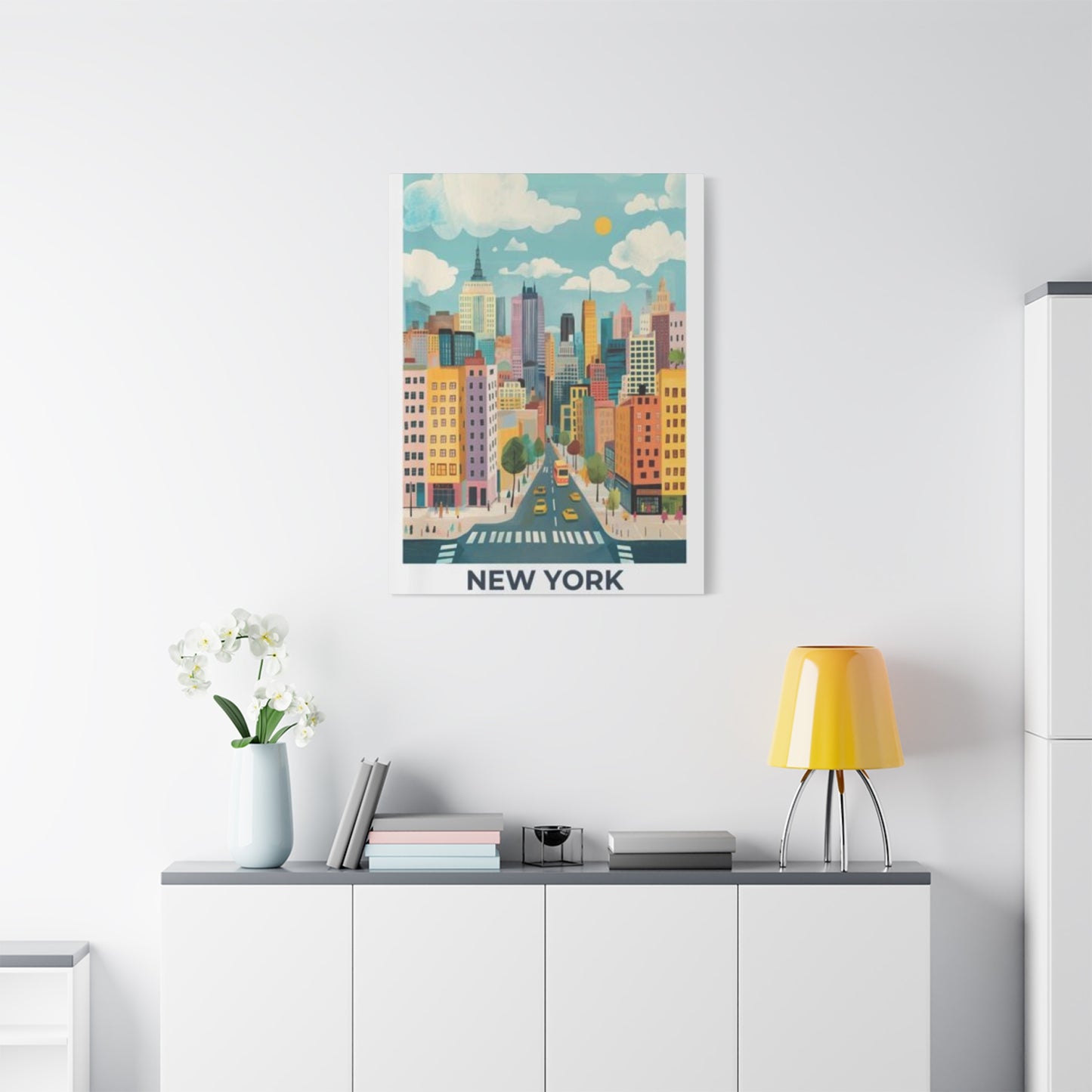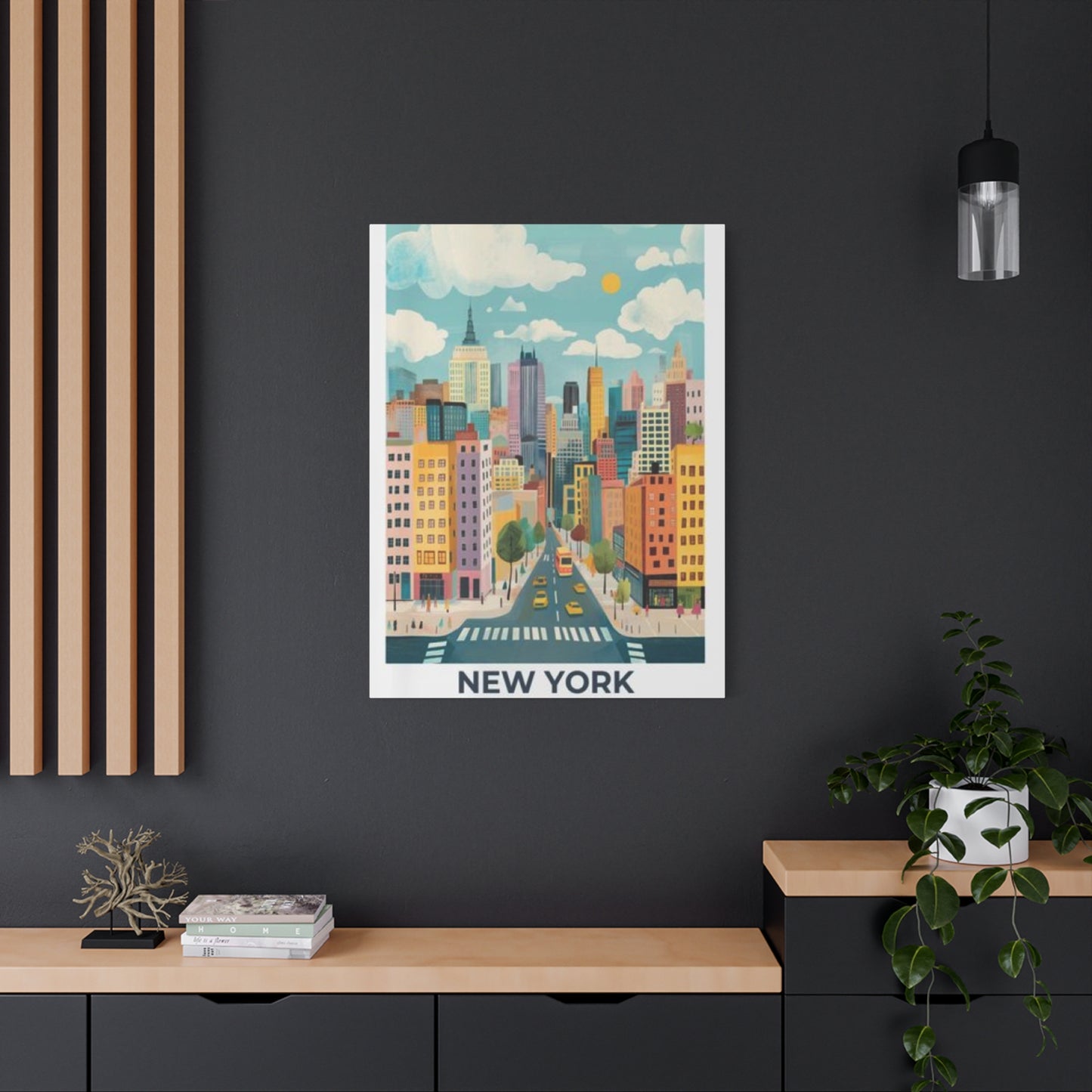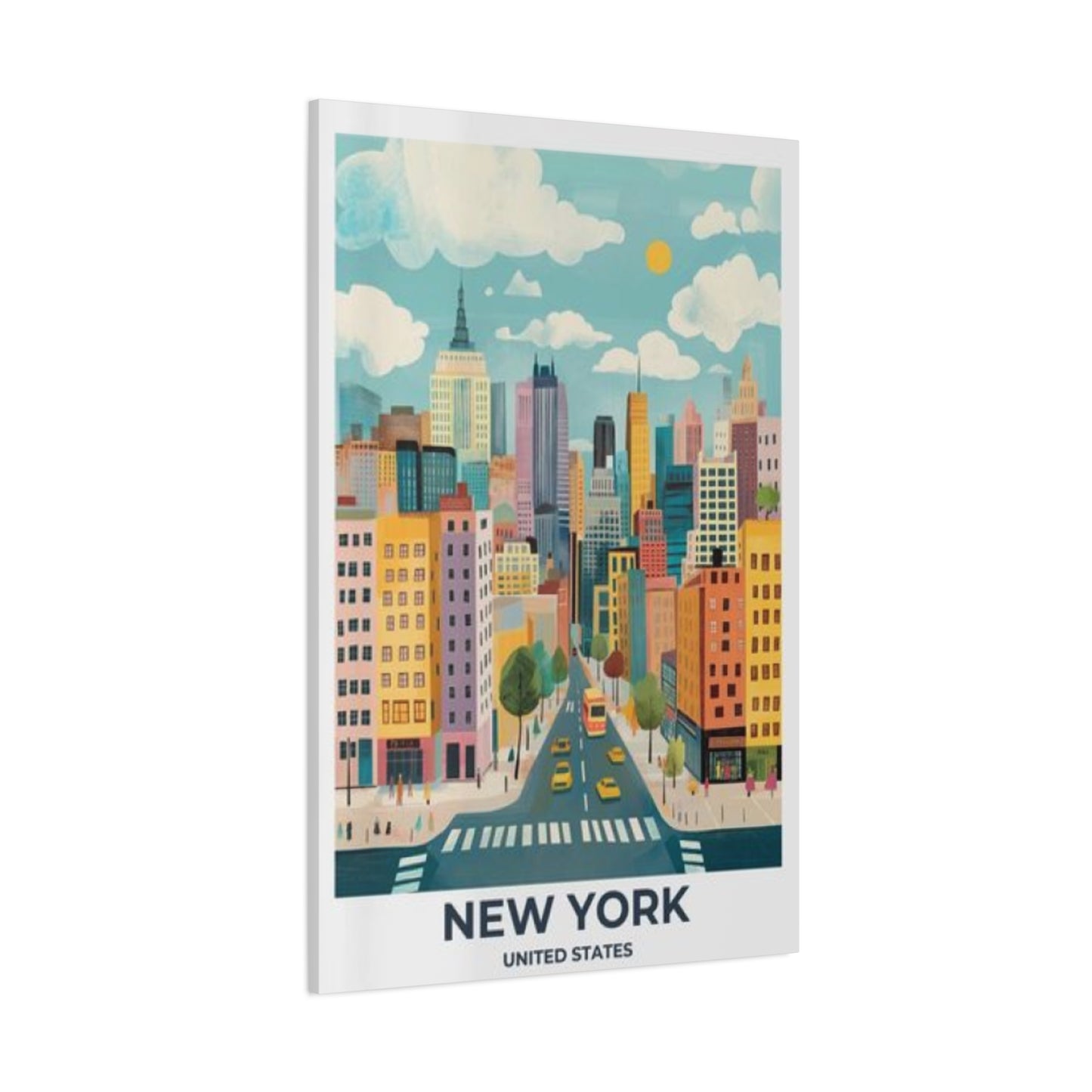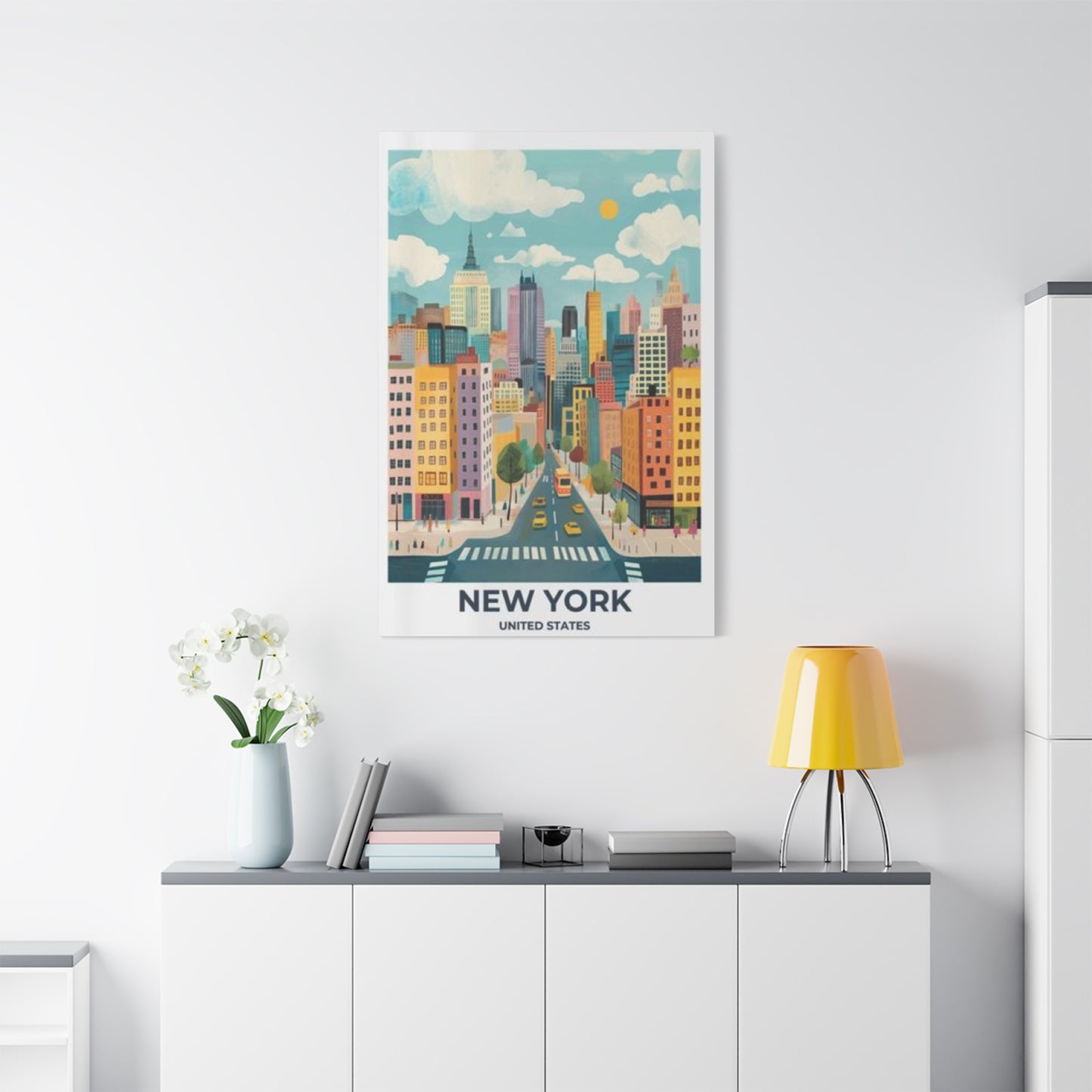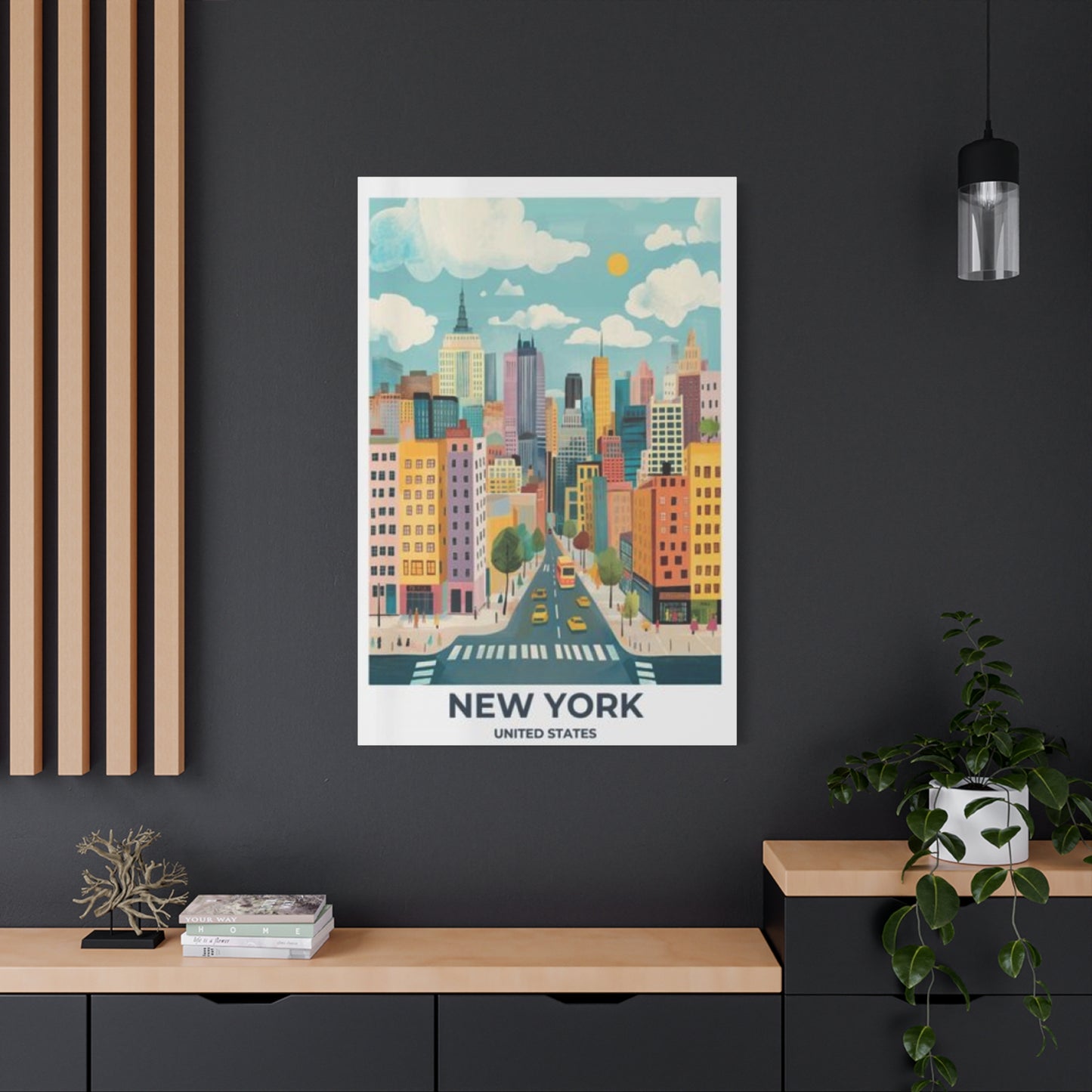Capturing the Soul of Manhattan: NYC Street Paintings and Skyline Wall Art for Your Home
New York City has long been a muse for artists around the world, inspiring countless works that capture its unique energy, architectural grandeur, and cultural diversity. The streets of NYC and its iconic skyline represent more than just urban landscapes; they embody dreams, ambition, and the vibrant pulse of American culture. When you bring a painting of New York streets or NYC skyline wall art into your space, you're not just adding decoration but inviting a piece of that magical energy into your daily life.
The appeal of NYC-themed artwork spans generations and design preferences. From vintage interpretations of old New York to contemporary abstract pieces, from realistic portrayals of famous landmarks to impressionistic captures of city life, the variety available ensures that every art lover can find something that resonates with their personal taste. This comprehensive exploration will guide you through everything you need to know about selecting, understanding, and displaying New York City street paintings and skyline wall art in your home or office.
Historical Evolution of New York City Art
The artistic representation of New York City has evolved dramatically over the centuries, mirroring the city's own transformation from a colonial port to a global metropolis. Early depictions from the 18th and 19th centuries showed a relatively modest settlement, with artists focusing on harbor scenes and pastoral elements that seem almost unrecognizable compared to the city we know today.
As New York grew throughout the 1800s, artists began documenting the rapid changes transforming the landscape. The construction of iconic buildings, the development of Central Park, and the influx of immigrants all became subjects worthy of artistic attention. These historical paintings serve as visual documentation of the city's incredible growth and the social changes that accompanied it.
The early 20th century brought revolutionary changes to NYC art. The Ashcan School emerged, with artists like John Sloan and George Bellows focusing on everyday life in the city streets. They painted tenements, street vendors, children playing in alleyways, and the gritty reality of urban existence. This movement marked a significant departure from idealized landscapes, embracing instead the raw authenticity of city life.
The construction of the first skyscrapers in the 1920s and 1930s introduced a new element to NYC artwork. Artists became fascinated with these towering structures that seemed to defy gravity and human limitations. The Art Deco movement influenced how these buildings were depicted, with clean lines, geometric patterns, and a sense of modernist optimism pervading the artwork of this era.
Post-World War II brought abstract expressionism to the forefront, with New York becoming the center of the art world. Artists like Jackson Pollock and Willem de Kooning, while not always directly depicting the city, were influenced by its energy and chaos. Their work captured the psychological impact of urban life in ways that realistic paintings never could.
The 1960s and 1970s saw pop art transform how artists approached NYC subjects. Andy Warhol and other pop artists incorporated commercial imagery, street signs, and consumer culture into their work, reflecting the city's increasing commercialization. This period also saw the rise of street art and graffiti as legitimate art forms, adding new layers to the conversation about what constitutes NYC art.
Contemporary artists continue to find new ways to interpret New York City. Digital art, mixed media, and innovative techniques allow for fresh perspectives on familiar scenes. Photographers turned artists, digital illustrators, and traditional painters all contribute to the ever-expanding body of work celebrating this remarkable city.
Iconic Neighborhoods Captured on Canvas
Each neighborhood in New York City possesses its own distinct character, and artists have long been drawn to capturing these unique atmospheres. Times Square, with its dazzling lights and constant motion, presents perhaps the most challenging yet rewarding subject for artists. Capturing the energy of this intersection requires not just technical skill but an understanding of how light, movement, and human activity combine to create an overwhelming sensory experience.
Greenwich Village has inspired artists for over a century, serving as a bohemian enclave where creativity flourished. Paintings of its tree-lined streets, historic brownstones, and intimate cafes evoke a sense of artistic heritage and intellectual community. The neighborhood's winding streets and preserved 19th-century architecture provide endless compositional opportunities for artists seeking to capture old New York charm.
Brooklyn has emerged as a major subject in contemporary NYC art, particularly neighborhoods like DUMBO and Williamsburg. The view of Manhattan from Brooklyn Bridge Park has become one of the most painted perspectives in modern NYC art. Artists love capturing the contrast between Brooklyn's historic warehouses and the gleaming Manhattan skyline across the East River, creating compositions that speak to both tradition and progress.
The Upper East Side and Upper West Side offer more refined, elegant subjects for artists. These neighborhoods feature grand architecture, museum facades, and tree-lined avenues that provide a softer, more classical take on city life. Artists painting these areas often focus on the interplay between natural elements like Central Park and the surrounding urban environment.
Chinatown and Little Italy present vibrant, culturally rich subjects with colorful storefronts, hanging lanterns, and crowded streets that tell stories of immigration and cultural preservation. Artists working in these neighborhoods often emphasize the sensory overload of colors, signs in multiple languages, and the dense layering of visual information that characterizes these areas.
SoHo and Tribeca, with their cast-iron architecture and cobblestone streets, offer a glimpse into 19th-century New York while serving as hubs for contemporary art galleries. The juxtaposition of historic buildings housing modern businesses creates interesting artistic tension that painters love to explore. The fire escapes, loading docks, and industrial elements provide strong geometric components for compositions.
Harlem's artistic representation has evolved significantly over the decades. From the Harlem Renaissance to contemporary times, artists have sought to capture the neighborhood's cultural significance, architectural beauty, and community spirit. The brownstones, churches, and public spaces of Harlem offer rich subject matter that carries historical and cultural weight.
The Financial District, with its canyon-like streets surrounded by towering buildings, creates dramatic plays of light and shadow that appeal to artists interested in more abstract or atmospheric interpretations. The contrast between historic sites like Trinity Church and modern glass towers provides compelling juxtapositions that speak to the city's layered history.
Architectural Landmarks in NYC Wall Art
The Empire State Building remains the most iconic subject in NYC skyline art. Its Art Deco design and historical significance make it instantly recognizable, and artists have depicted it in countless styles and moods. From sunrise paintings showing the building bathed in golden light to nighttime scenes where it glows against the dark sky, this landmark offers endless interpretive possibilities.
The Chrysler Building, with its distinctive crown and Art Deco details, appeals to artists drawn to geometric patterns and architectural ornamentation. Its metallic spire catches light in unique ways throughout the day, providing dynamic subjects for artists interested in how architecture interacts with natural light. Many consider it the most beautiful building in New York, and paintings often emphasize its elegant proportions and decorative elements.
Brooklyn Bridge has been painted thousands of times since its completion, yet artists continue finding new perspectives and interpretations. The bridge's Gothic arches and web of suspension cables create strong compositional elements that work well in various artistic styles. Whether viewed from Manhattan, Brooklyn, or from the bridge itself, this structure provides powerful symbolic and visual content.
One World Trade Center represents resilience and renewal in NYC art. As the tallest building in the Western Hemisphere, it dominates the downtown skyline and carries profound emotional significance. Artists approach this subject with varying degrees of abstraction and realism, often incorporating themes of remembrance, hope, and strength into their depictions.
The Flatiron Building's unique triangular shape has fascinated artists since its construction. Its position at the intersection of Fifth Avenue and Broadway creates interesting urban geometry that painters love to explore. The building's relatively modest height compared to modern skyscrapers gives it an approachable, almost charming quality that translates well to various artistic styles.
Radio City Music Hall and Rockefeller Center represent mid-century New York glamour. Artists depicting these landmarks often focus on their entertainment heritage, Art Deco details, and the bustling activity surrounding them. The seasonal elements, particularly the Christmas tree at Rockefeller Center, add temporal specificity that many artists incorporate into their work.
Grand Central Terminal's Beaux-Arts facade and celestial ceiling have inspired countless paintings. The building's interior spaces, with dramatic lighting streaming through large windows, create almost cathedral-like atmospheres that artists love to capture. The constant flow of commuters adds human scale and energy to these architectural paintings.
The High Line, though a relatively recent addition to NYC's landscape, has quickly become a favorite subject. This elevated park built on historic freight rail lines offers unique perspectives on the city, with plantings framing views of surrounding architecture. Artists appreciate how the High Line combines nature, history, and contemporary urban design in one linear space.
Painting Techniques for Urban Landscapes
Impressionist techniques applied to NYC street scenes create atmospheric paintings that capture the energy and movement of city life without getting bogged down in precise details. Quick brushstrokes suggest the blur of passing traffic, the crowds of pedestrians, and the play of light on wet pavement. This approach emphasizes overall impression and mood over photographic accuracy, allowing viewers to fill in details with their imagination.
Photorealistic painting techniques create incredibly detailed NYC scenes that rival photographs in their precision. Artists working in this style spend hundreds of hours perfecting every reflection in windows, every brick in buildings, and every detail of street furniture. These paintings appeal to viewers who appreciate technical virtuosity and want artwork that captures specific locations with documentary accuracy.
Palette knife techniques produce textured, dynamic NYC paintings with thick paint application that creates almost sculptural surfaces. This approach works particularly well for capturing the rough textures of city buildings, the chaos of busy streets, and the energy of urban life. The physical texture of the paint itself becomes part of the artwork's message about the tangible, gritty reality of the city.
Watercolor techniques bring a lighter, more delicate approach to NYC street scenes. The transparent washes and fluid nature of watercolor create atmospheric paintings that suggest rather than define urban elements. This medium works beautifully for capturing weather effects, the quality of light at different times of day, and the feeling of space and air between buildings.
Mixed media approaches combine various materials and techniques to create layered, complex NYC artworks. Artists might incorporate collage elements like vintage maps, subway tokens, or newspaper clippings with painted elements. This technique can add conceptual depth and textural interest while creating connections between the artwork and actual city materials.
Abstract expressionist techniques applied to NYC subjects capture emotional and psychological responses to the city rather than literal appearances. Gestural brushwork, drips, and bold color fields might represent the overwhelming nature of city life, the rhythm of traffic, or the emotional intensity of living among millions of people. These paintings prioritize feeling over representation.
Pop art techniques bring graphic clarity and bold colors to NYC subjects, often incorporating elements of commercial art, signage, and consumer culture. This approach acknowledges the city's role as a commercial and cultural center while creating artwork that's accessible and visually striking. Flat areas of color, strong outlines, and simplified forms characterize this style.
Traditional oil painting techniques using glazing and layering create luminous NYC scenes with depth and atmospheric perspective. Building up transparent layers over time allows artists to achieve subtle color variations and the complex interplay of light that characterizes urban environments. This classical approach brings fine art tradition to contemporary subjects.
Composition Strategies for Skyline Art
Leading lines created by streets, bridges, or architectural elements guide viewer attention through NYC skyline compositions. Artists strategically position these linear elements to create depth, movement, and visual pathways that direct the eye toward focal points. The grid pattern of city streets provides natural leading lines that can be exploited for strong compositional structure.
Foreground, middle ground, and background layering creates depth in skyline paintings. Artists might place park elements or water in the foreground, mid-rise buildings in the middle ground, and soaring skyscrapers in the background. This layering creates atmospheric perspective and gives viewers a sense of moving through space toward the distant skyline.
Framing techniques use architectural elements, trees, or other structures to frame views of the skyline within the composition. Looking through a window, under a bridge, or between buildings creates natural frames that focus attention while adding compositional complexity. This technique also provides context and scale for the skyline elements.
Rule of thirds application places key skyline elements at intersecting points of an imaginary grid dividing the canvas into nine equal parts. Positioning the horizon line, prominent buildings, or other focal points at these intersection points creates balanced, visually pleasing compositions that feel natural to viewers. Breaking this rule intentionally can create tension or emphasize unusual perspectives.
Symmetrical compositions centered on iconic buildings or streets create formal, stable feelings that emphasize architectural grandeur. This approach works particularly well for subjects like the Empire State Building or views down major avenues. The symmetry suggests order, permanence, and the monumental quality of city architecture.
Asymmetrical balance creates more dynamic, contemporary feeling skyline compositions. Placing visual weight unevenly across the canvas while maintaining overall balance creates energy and movement. This approach feels more modern and candid, suggesting spontaneous observation rather than careful construction.
Aerial perspectives looking down on the city create unique compositional opportunities. These bird's-eye views emphasize the grid pattern of streets, the variety of building heights, and the relationship between built environment and natural features like rivers and parks. Aerial perspectives make familiar scenes appear abstract and geometric.
Reflections in water or glass double the visual information in skyline paintings and create mirror-image compositions. Artists use reflections in the East River, Hudson River, or building windows to create complex, layered images that play with reality and representation. Reflections also allow for interesting color and light effects as they often show different tones than their sources.
Lighting Effects in NYC Scenes
Golden hour lighting creates some of the most dramatic and beautiful NYC paintings. The warm, low-angle sunlight shortly after sunrise or before sunset bathes buildings in golden light while creating long shadows that emphasize architectural forms. During these magic hours, the city seems to glow from within, and even ordinary buildings become extraordinary subjects.
Blue hour, that brief period after sunset or before sunrise when the sky takes on deep blue tones, offers unique opportunities for NYC art. City lights are visible but natural light still provides some illumination, creating a beautiful balance between artificial and natural light sources. This transitional time creates moody, atmospheric paintings that capture the city's dual nature.
Nighttime illumination from street lights, building windows, neon signs, and vehicle lights creates complex lighting scenarios that challenge and inspire artists. The multiple light sources create varied color temperatures and intensities, adding visual interest and directing viewer attention. Nighttime NYC paintings often emphasize the city that never sleeps, showing vitality and energy continuing after dark.
Reflected light from glass and steel buildings creates secondary light sources that bounce around urban canyons. Artists must understand how light reflects and multiplies in the city environment to create convincing paintings. These reflections add complexity and luminosity to paintings while challenging artists to observe carefully and think about light behavior.
Backlighting creates dramatic silhouettes when buildings or other subjects are positioned between the viewer and bright light sources. This technique simplifies forms into strong shapes while creating high contrast that's visually striking. Backlit scenes work particularly well for skyline paintings where building profiles become graphic elements against brilliant skies.
Dappled light filtering through trees or between buildings creates patterns and visual interest in street scene paintings. These light patterns add texture and movement to otherwise static scenes while creating opportunities to show the interaction between natural and built environments. Dappled light also creates a more intimate, human scale in urban paintings.
Stormy light just before or after storms creates dramatic skies with unusual color combinations and stark contrasts. Dark storm clouds make lit buildings appear brighter by comparison, and the quality of light becomes charged with energy. These conditions create paintings with emotional intensity and dramatic atmosphere that appeal to collectors seeking impactful artwork.
Artificial light color temperatures vary from warm incandescent yellows to cool fluorescent blues, creating complex color harmonies in nighttime NYC scenes. Understanding and depicting these different light qualities adds realism and visual interest. The contrast between warm indoor light visible through windows and cool outdoor street lighting creates compelling compositions.
Framing Options for NYC Paintings
Traditional wood frames in classic profiles complement NYC artwork while adding formal elegance. Rich woods like walnut or mahogany work beautifully with vintage or classical style NYC paintings, enhancing their timeless quality. The frame becomes part of the artwork's presentation, adding value and protecting the painting while contributing to overall aesthetic.
Modern minimalist frames with simple profiles keep focus on the artwork rather than the frame. Thin black, white, or metallic frames provide just enough definition and protection without adding visual weight. This approach works particularly well with contemporary NYC art where clean lines and modern aesthetics dominate.
Floating frames create the illusion that the canvas is suspended within the frame, adding depth and contemporary style. This presentation method works especially well with gallery-wrapped canvases where the painted image continues around the edges. The floating effect adds sophistication and modernity to NYC skyline art.
Metal frames in aluminum or steel provide industrial aesthetic that complements urban subject matter. The metallic finish echoes the steel and glass of NYC architecture, creating thematic coherence between subject and presentation. Metal frames also offer durability and a sleek, contemporary look that appeals to modern collectors.
Gallery wrap presentation dispenses with traditional frames entirely, allowing the painted edges of the canvas to remain visible. This approach creates a clean, contemporary look and eliminates the visual barrier that frames can create. Gallery wrapped NYC canvases work well in modern interiors and reduce overall cost by eliminating framing expense.
Ornate gilded frames can work surprisingly well with certain NYC paintings, particularly those with classical or vintage aesthetics. Gold or silver leaf frames add luxury and formality, elevating the artwork and making it feel more precious. This approach works best with more traditional painting styles and in formal interior settings.
Shadow box frames create depth by spacing the artwork away from the wall, adding dimensional interest. These frames work well with mixed media pieces or when wanting to emphasize the artwork as a three-dimensional object. The added depth creates interesting shadows and makes the piece more sculptural.
Custom framing allows for perfect coordination between artwork, frame, and matting to create cohesive presentation. Professional framers can help select materials and styles that enhance specific NYC paintings while complementing the intended installation space. Custom framing represents an investment that protects artwork and maximizes its visual impact.
Display Locations for NYC Wall Art
Living room placement makes NYC artwork a central element of daily life and conversation. These social spaces allow artwork to be shared with family and guests, making them ideal for impactful skyline paintings or dramatic street scenes. Consider sight lines from seating areas to ensure the artwork can be comfortably viewed and appreciated.
Bedroom walls offer opportunities for more personal, contemplative NYC art selections. Nighttime skyline scenes or quieter neighborhood views create appropriate atmospheres for rest and reflection. Artwork in bedrooms should promote the desired mood, whether that's energizing urban excitement or peaceful escape.
Home office spaces benefit from NYC artwork that inspires productivity and ambition. Skyline views suggesting success and achievement can motivate while working, while street scene paintings add visual interest during video calls or break times. Consider how the artwork will appear in the background of video conferences if relevant.
Entryway or foyer placement gives NYC art prime visibility as people enter the space, making a strong first impression. Bold skyline pieces or dramatic architectural paintings work well in these transitional spaces, setting the tone for the entire home. Entry art should be impactful and welcoming while introducing your aesthetic sensibilities.
Dining room walls provide opportunities for sophisticated NYC artwork that enhances the experience of meals and entertaining. The artwork becomes a talking point during dinners while adding visual richness to the space. Consider how lighting conditions during typical dining times will affect the artwork's appearance.
Hallway galleries transform narrow transitional spaces into art exhibitions. Series of smaller NYC paintings depicting different neighborhoods or views create journey-like experiences as people move through the space. Hallways offer opportunities to display multiple related pieces that might overwhelm in a single room.
Kitchen spaces increasingly feature artwork, with NYC street scene paintings adding urban energy to cooking and gathering areas. Consider durability and protection from cooking moisture and heat when selecting and placing kitchen art. Vibrant, colorful NYC market or street vendor scenes complement the food-related activities of kitchens.
Commercial spaces like offices, restaurants, hotels, and retail stores use NYC artwork to establish brand identity and create desired atmospheres. Large-scale skyline installations in lobbies impress visitors, while smaller pieces in offices and rooms create cohesive themes. Commercial applications often require series of related pieces maintaining visual consistency across large spaces.
Art Styles for NYC Paintings
Realistic representational style captures NYC with photographic accuracy and attention to detail. These paintings document specific locations at specific moments, creating works that serve as visual records as well as art. Realism appeals to viewers who want recognizable, accurate depictions of favorite places or landmarks, offering familiarity and nostalgia.
Impressionist interpretations use loose brushwork and emphasis on light effects to capture the feeling and atmosphere of NYC rather than precise details. These paintings suggest urban energy through technique itself, with quick strokes evoking movement and life. Impressionism allows artists to convey subjective experiences of the city in ways that strict realism cannot.
Abstract approaches reduce NYC to essential forms, colors, and relationships, emphasizing compositional elements over representation. Geometric abstractions might reference the grid of city streets or the vertical lines of skyscrapers without literally depicting them. Abstract NYC art appeals to collectors seeking sophisticated, contemporary work that suggests rather than shows.
Expressionist paintings prioritize emotional content over accurate representation, using distorted forms and intense colors to convey feelings about NYC. The overwhelming nature of city life, the loneliness possible amid millions, or the excitement of endless possibilities can all be expressed through exaggerated forms and non-naturalistic colors.
Pop art style brings graphic sensibility and cultural commentary to NYC subjects. Borrowing from commercial art, advertising, and signage, pop art NYC paintings acknowledge the city's commercial nature while creating accessible, visually striking work. This style often incorporates text, familiar logos, and flat color areas for maximum impact.
Vintage or retro styles evoke specific historical periods through stylistic choices that reference mid-century design, old travel posters, or historic painting techniques. These works create nostalgia for earlier eras of NYC history, appealing to those who romanticize the past or appreciate period aesthetics. Vintage styles often use limited color palettes and simplified forms reminiscent of older printing techniques.
Contemporary urban realism combines realistic technique with modern compositional and conceptual approaches. These paintings might include unusual perspectives enabled by drone photography or security cameras, or incorporate contemporary social commentary about city life. The style acknowledges traditional realism while pushing it in new directions relevant to current times.
Mixed media collage approaches combine painting with other materials and techniques to create layered, complex NYC artworks. Incorporating actual city materials like maps, newspapers, or found objects grounds the work in physical reality while allowing for conceptual depth. This approach creates textured, dimensional pieces that reward close examination.
Subject Matter Beyond Skylines
Street level scenes showing pedestrians, vendors, and daily activities bring human scale and narrative content to NYC artwork. These paintings tell stories about individual lives and experiences rather than focusing on architectural grandeur. Street scenes create empathy and connection, reminding viewers that cities are fundamentally about people.
Transportation subjects including subways, taxis, buses, and bike messengers emphasize NYC's constant movement and the systems that keep the city functioning. These elements add action and energy to paintings while serving as symbols of urban life. Yellow cabs in particular have become such strong NYC symbols that their inclusion immediately locates a painting.
Parks and green spaces within the city provide contrast to built environment and show NYC's softer side. Central Park paintings demonstrate how nature and city coexist, offering breathing room and recreational space. Park scenes allow artists to include seasonal elements, natural forms, and more relaxed human activities than busy street scenes show.
Waterfront views from Brooklyn Bridge Park, Battery Park, or various piers emphasize NYC's island geography and maritime history. Water adds reflective surfaces, horizontal calm contrasting with vertical buildings, and sense of openness often missing from street-level views. Waterfront paintings show the city from positions of remove, allowing for contemplation.
Interior views looking out windows toward NYC scenes create interesting frame-within-frame compositions. These paintings acknowledge the viewer's position, making them more intimate and personal. Window views also allow artists to include interior elements that provide contrast and context for the urban views beyond.
Cultural landmarks including museums, theaters, and performance venues celebrate NYC's role as cultural capital. These subjects appeal to art lovers, theater enthusiasts, and those who value the city's contribution to world culture. Paintings of these institutions carry associations with creativity, excellence, and cultural achievement.
Food and dining scenes from street vendors to famous restaurants emphasize NYC's incredible culinary diversity. Hot dog stands, pizza shops, ethnic restaurants, and upscale dining establishments all reflect different aspects of city culture. Food-related paintings appeal to viewers' sensory memories and associations between food and community.
Retail and commerce subjects from small shops to department stores show NYC's commercial vitality. Window displays, street shopping, and bustling retail districts demonstrate the city's role as consumer capital. These subjects allow artists to include abundant visual detail, reflections, and the interaction between commerce and daily life.
Materials and Media for NYC Art
Oil paint remains the traditional choice for serious NYC paintings, offering rich colors, blendability, and archival permanence. The slow drying time of oils allows for extensive working and reworking, letting artists achieve subtle color transitions and complex layering. Oil paintings carry associations with fine art tradition and tend to command higher prices than works in other media.
Acrylic paint provides versatility, quick drying time, and durability for NYC artwork. Acrylics can mimic oil paint techniques or be used in ways unique to the medium, including staining and pouring techniques. The water-based nature makes acrylics less toxic and easier to work with, while modern formulations offer excellent color permanence and flexibility.
Watercolor creates delicate, luminous NYC scenes with transparent washes and fluid transitions. This medium works beautifully for atmospheric perspectives, weather effects, and the interplay of light and air in urban environments. Watercolor paintings feel lighter and more spontaneous than oils, appealing to collectors who appreciate delicacy and technical mastery.
Gouache combines watercolor's water-soluble convenience with opaque coverage similar to acrylics. This medium allows for both transparent and opaque techniques, making it versatile for NYC subjects requiring both detail and bold color areas. Gouache has been popular for illustration and design work, lending a graphic quality when used for urban scenes.
Pastel drawings create soft, velvety NYC scenes with direct color application and easy blending. Soft pastels offer intense, pure color while oil pastels provide waxy richness and the ability to create impasto effects. Pastel work requires protective framing with glass or acrylic but offers unique surface qualities and luminous color that collectors appreciate.
Ink work, whether pen and ink or brush and ink, creates bold, graphic NYC images with strong contrast. Black ink on white paper produces dramatic, high-contrast images that emphasize form and line over color. Adding color washes to ink drawings combines the clarity of line work with the atmosphere of color, creating hybrid techniques popular for urban sketching.
Mixed media approaches combine multiple materials to create layered, complex NYC artworks. Artists might incorporate collage elements, found materials, transfer techniques, and various paint media within single pieces. Mixed media work often has rich surface texture and conceptual depth, appealing to sophisticated collectors who appreciate technical innovation.
Digital art and printing technologies allow artists to create NYC images using computers, tablets, and specialized software. Digital work can achieve effects impossible with traditional media or can convincingly mimic traditional techniques. High-quality digital prints on canvas or fine art paper make NYC artwork more accessible while allowing artists to produce multiples of successful images.
Printmaking techniques including lithography, screen printing, and etching create NYC art with distinctive qualities specific to each process. Limited edition prints signed and numbered by artists offer more affordable entry points for collecting while maintaining artistic value. The printmaking process itself often influences aesthetic decisions, creating works that look distinctly different from paintings.
Photography as art captures NYC with mechanical precision or artistic interpretation depending on approach. From straight documentary photography to heavily manipulated fine art images, photographic NYC art ranges widely in style and intent. Many contemporary artists blur lines between photography and painting through digital manipulation or hand-worked prints.
Photography Versus Painting
Photographic accuracy captures NYC with mechanical precision documenting exact appearances at specific moments. Photography excels at freezing action, recording details, and providing documentary evidence of reality. For those seeking literal representations of favorite locations, high-quality NYC photography offers unmatched accuracy and often at lower costs than paintings.
Artistic interpretation in paintings allows subjective responses to NYC that transcend literal appearance. Painters inject personal vision, emotional content, and conceptual meaning into urban scenes through color choices, compositional decisions, and stylistic approaches. This interpretive quality makes each painting unique and offers viewers windows into artist perspectives rather than just mechanical recording.
Technical processes differ fundamentally between photography and painting, with photographers controlling exposure, focus, and timing while painters build images through accumulated marks over time. Understanding these process differences helps collectors appreciate what each medium offers and which better suits their preferences and aesthetic goals.
Multiple versus unique pieces distinguishes photography's reproducibility from painting's uniqueness. Photographers can produce multiple prints from single negatives or files, while each painting is inherently unique even when artists repeat similar subjects. This affects pricing, with unique paintings generally commanding higher prices than edition prints.
Emotional response differences exist between viewing photographs and paintings of same subjects. Paintings carry evidence of human touch through visible brushstrokes and physical paint, creating intimate connections between viewer and artist. Photographs might feel more immediate but can lack the warmth of handmade objects.
Historical tradition positions painting as fine art with centuries of established value, while photography fought for art world acceptance throughout its history. These perceptions affect how different collectors value photographic versus painted NYC artwork. Younger collectors often embrace photography more readily while traditional collectors prefer paintings.
Investment considerations differ between media, with paintings by recognized artists generally appreciating more reliably than photographic prints. However, rare photographs by important photographers can command astronomical prices, so medium alone doesn't determine investment value. Artist reputation and work quality matter most regardless of medium.
Personal preference ultimately determines best choice between photography and painting for individual collectors. Some people respond more strongly to painterly qualities while others prefer photographic precision. Understanding your aesthetic preferences through exposure to both media helps guide collecting decisions toward work you'll love living with long-term.
Digital Art and Prints
Digital creation methods use computer software, graphic tablets, and styluses to produce NYC artwork entirely through digital means. Digital artists work in programs simulating traditional media or embracing purely digital aesthetics impossible in physical media. This approach offers unlimited experimentation, easy revision, and ability to produce variations exploring different color schemes or compositions.
Print quality determines how successfully digital files transfer to physical formats, with museum-quality giclee printing producing archival prints rivaling traditional fine art. Inferior printing on cheap materials results in disappointing reproductions that fade quickly and lack richness. Understanding printing quality differences helps collectors make informed decisions about digital NYC artwork.
Edition sizes for digital prints directly affect individual print values, following traditional printmaking models. Open editions allowing unlimited printing offer minimal investment value while strictly limited numbered editions signed by artists maintain higher values. Some digital artists create unique pieces by hand-embellishing prints, making each technically unique.
Authenticity verification becomes complex with digital art since perfect reproductions are possible. Certificates of authenticity, artist signatures, and edition numbering provide some security, but buyers should purchase from reputable sources. Blockchain technology and NFTs offer new authentication methods gaining adoption in digital art markets.
Advantages of digital approach include perfect reproducibility ensuring consistency across edition, easier storage and shipping of files, and flexibility in output sizing. Digital artists can produce various print sizes from single files and easily update or revise work. These practical benefits make digital creation increasingly popular.
Traditional feel concerns some collectors who prefer handmade physical artwork over computer-generated images. Digital prints can look flat or mechanical compared to paintings with physical texture and mark-making evidence. However, high-quality digital prints on proper substrates overcome many objections, and aesthetic preferences ultimately matter most.
Hybrid approaches combining digital and traditional techniques create unique possibilities. Artists might paint traditionally then scan and digitally enhance work, or print digital compositions then add hand-painted elements. These hybrid methods bridge digital and traditional approaches, offering advantages of both.
Market acceptance of digital art continues growing as younger collectors comfortable with digital culture enter market and blockchain technologies provide authentication solutions. Major auction houses now regularly feature digital artwork, signaling mainstream acceptance. Digital NYC art represents legitimate collecting category with its own aesthetic and market.
Cultural Significance of NYC in Art
Symbol of opportunity reflects NYC's role in American mythology as place where anyone can succeed through talent and determination. Artwork celebrating this aspect often emphasizes skyline grandeur, soaring skyscrapers, and triumphant perspectives suggesting achievement and possibility. These pieces resonate with viewers who share or aspire to this optimistic worldview.
Immigrant experience and cultural diversity make NYC subject for artwork exploring American identity and multicultural society. Paintings of ethnic neighborhoods, diverse street scenes, and cultural landmarks acknowledge the city's role as entry point and home for people from everywhere. This thematic content adds depth and meaning beyond pure aesthetics.
Economic powerhouse imagery positions NYC as financial capital and center of global commerce. Artwork depicting Wall Street, corporate headquarters, and commercial districts references this economic significance. These pieces appeal particularly to business environments where they reinforce values of success, ambition, and professional achievement.
Arts and culture center status makes NYC supremely appropriate subject for artwork celebrating creativity itself. Paintings of museums, theaters, and galleries create reflexive art about art, appealing to collectors who value cultural participation and intellectual engagement. NYC's artistic heritage adds layers of meaning to artwork depicting cultural landmarks.
Urban life experience both challenges and excites, and NYC artwork often explores tensions between isolation and community, wealth and poverty, beauty and decay. Artists use NYC subjects to comment on modern urban existence more broadly, making these paintings relevant beyond specific geographic reference to universal human experiences.
Historical events from building construction to terrorist attacks have made NYC symbol of resilience, ambition, and American identity. Artwork referencing these events carries emotional weight and historical significance beyond aesthetic qualities. The destroyed twin towers appear in vintage NYC paintings, serving as poignant reminders of loss and resilience.
Popular culture presence through countless movies, shows, books, and songs makes NYC perhaps most familiar city for people who have never visited. Artwork depicting recognizable locations triggers memories of favorite cultural moments, creating personal connections. This familiarity makes NYC art accessible and emotionally resonant for wide audiences.
Personal connection for former residents, frequent visitors, or those who dream of visiting creates markets for NYC artwork based on individual relationships with the city. People display NYC art to commemorate experiences, maintain connections, or express aspirations. These personal motivations drive much NYC art collecting beyond purely aesthetic considerations.
Online Marketplaces for NYC Art
Artist websites provide direct access to creators, allowing collectors to purchase NYC artwork directly without gallery markup. Many artists maintain online shops with current availability, pricing, and shipping information. Direct purchasing supports artists maximally while offering collectors opportunities to communicate directly with creators about work, customization, or commissions.
Online gallery platforms aggregate work from multiple artists, creating virtual galleries where collectors browse curated selections. These platforms often provide some vetting of artist quality while offering more selection than individual artist sites. Services vary but may include authentication, shipping coordination, and payment plans making purchasing easier.
Marketplace platforms connect buyers and sellers in less curated environments where anyone can list artwork. These sites offer vast selection and competitive pricing but require more buyer diligence regarding authenticity and quality. Reading seller reviews and understanding return policies becomes essential when using these marketplace platforms.
Auction sites online extend traditional auction houses into digital space, allowing bidding on NYC artwork from anywhere. Major auction houses stream live auctions and maintain online-only sales, while specialized art auction sites focus exclusively on artwork. Auction buying requires understanding bidding processes, buyer's premiums, and condition reports.
Social media platforms increasingly serve as artwork marketplaces with artists showcasing and selling work directly to followers. Platforms with strong visual components allow artists to build audiences and collectors to discover emerging talent. Direct messaging facilitates transactions, though platforms may lack purchase protection and formal processes.
Print-on-demand services allow artists to upload designs that get printed and shipped as orders arrive, eliminating inventory requirements. These services make NYC art widely accessible at low prices though quality varies significantly between providers. Artists benefit from easy distribution while collectors access affordable artwork, though pieces lack uniqueness.
Specialized art platforms focusing specifically on fine art provide curated experiences between individual artist sites and general marketplaces. These platforms often verify artist credentials, provide expert guidance, and offer services like art advisory, framing, and installation. Premium services come with higher prices but increased confidence in purchases.
Comparison shopping across platforms helps collectors find best prices, selections, and services for NYC artwork purchases. Prices for similar pieces vary considerably between platforms based on commission structures, service levels, and marketing approaches. Savvy collectors research multiple sources before making significant purchases.
Architectural Details in NYC Art
Fire escapes as iconic NYC elements appear in countless paintings, providing geometric interest, suggesting urban density, and evoking classic New York character. These zigzagging metal structures create strong diagonal lines in compositions while serving as symbols of urban life. Artists emphasize their industrial beauty and the way they texture building facades.
Cornices and decorative moldings from pre-modern architecture add ornamental richness to NYC building paintings. These elaborate details reflect eras when craftsmanship and decoration mattered greatly in construction. Capturing these elements requires careful observation and technical skill but rewards with paintings that celebrate architectural artistry.
Window arrangements create patterns and rhythms across building facades that artists exploit for compositional structure. Regular window grids provide geometric order, while irregular arrangements create more organic, varied compositions. Illuminated windows at night become individual narrative elements suggesting thousands of separate lives within single buildings.
Brick and stone textures define much of NYC's architectural character, with weathered materials showing decades or centuries of history. Artists working realistically must master techniques for depicting various material surfaces convincingly. More impressionistic approaches suggest textures through paint application rather than detailed rendering.
Rooftop structures including water towers, mechanical equipment, and rooftop gardens add visual interest to NYC paintings showing elevated perspectives. These functional elements become sculptural forms from certain angles, and their industrial character contrasts interestingly with residential or commercial spaces below them.
Street-level details including storefronts, doorways, stoops, and sidewalk elements ground NYC paintings in specific times and places. These small details communicate neighborhood character and socioeconomic contexts more effectively than grand architectural gestures. Artists interested in storytelling focus on street-level elements that reveal how people interact with urban space.
Glass and steel modern architecture creates reflective surfaces, geometric forms, and interactions with light that differ dramatically from older buildings. Contemporary NYC paintings must address these newer aesthetic elements while considering how they relate to historic structures. The contrast between old and new architecture provides conceptual content about change and preservation.
Structural elements including columns, beams, and support systems sometimes become subjects themselves, particularly in paintings of bridges, elevated trains, or construction sites. Exposing structural bones appeals to artists interested in how cities function mechanically, revealing infrastructure usually hidden behind finished surfaces.
Conclusion
To capture the soul of Manhattan through art is to capture the essence of human energy itself—the unending rhythm, resilience, and brilliance of a city that never pauses. Whether through expressive NYC street paintings or panoramic skyline wall art, these works breathe life into interiors by reflecting the dynamic heartbeat of New York City. They remind us that beyond the glass towers and crowded avenues lies a deeper story—a story of dreams, creativity, and perseverance.
Each piece of Manhattan-inspired art serves as a visual tribute to the city’s contrasts: movement and stillness, history and progress, individuality and unity. Street paintings channel the raw pulse of daily life—vendors on corners, taxis in motion, and pedestrians crossing under neon lights. They capture fleeting emotions and lived moments, giving your walls an electric authenticity that connects you directly to the streets of New York. In contrast, skyline wall art pulls back the lens, presenting the grandeur of architecture and light that defines the city’s silhouette. Together, they portray the duality that makes Manhattan timeless—its chaos and its calm.
From a design perspective, Manhattan wall art effortlessly enhances a range of modern interiors. Minimalist rooms benefit from monochrome or sepia skyline prints that emphasize structure and sophistication, while vibrant street scenes add warmth and vitality to contemporary or industrial spaces. The color palette—deep grays, metallic silvers, and citylight golds—echoes the architectural energy of New York’s skyline. When placed strategically, these artworks can anchor a room, evoke nostalgia, or inspire the urban ambition that the city embodies.
Emotionally, NYC-themed art offers more than aesthetic pleasure—it brings a connection to possibility. New York is not merely a city; it’s a state of mind. Hanging these paintings or prints at home allows you to channel that energy every day—the sense that life is moving, opportunity is near, and creativity thrives in the unlikeliest corners. For those who’ve walked its streets or dream of doing so, these artworks act as personal reminders of inspiration, grit, and discovery.
Artists who depict Manhattan often approach it with deep respect for its layered identity. Some highlight its architectural majesty through precision and detail, while others focus on impressionistic strokes that capture its ever-shifting mood. Regardless of style, each interpretation offers a piece of the city’s soul—a reflection of humanity’s ceaseless desire to build, connect, and create. This diversity in artistic expression mirrors the city itself, where countless stories coexist in harmony.
Ultimately, NYC street paintings and skyline wall art do more than decorate—they encapsulate emotion, motion, and aspiration. They turn walls into portals, inviting the spirit of Manhattan into your daily life. Whether it’s the quiet glow of city lights at dusk or the kinetic energy of a bustling street corner, these artworks allow you to experience the city’s pulse without ever leaving home.
To bring Manhattan into your space is to invite its timeless allure—a fusion of ambition, artistry, and wonder. It’s not just about seeing New York; it’s about feeling it. Through this art, you celebrate the essence of urban life, capturing a city’s soul that continues to inspire the world—one skyline, one street, and one masterpiece at a time.

















